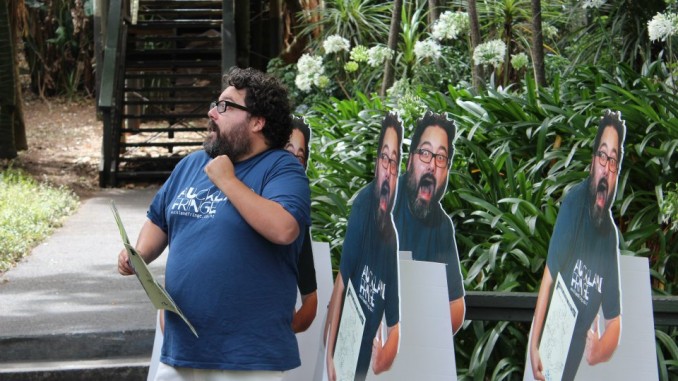
Memories from the Fringe [by James Wenley]
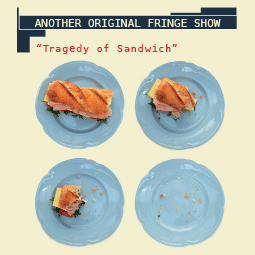
It was an obsession. It was an addiction. Auckland Fringe came into my life with a wink and a smile; a mistress that promised the world. Sure, some of the time we spent together was a bit awkward, rubbish even, but when it was good it was very good – whisking me away to show after show. By the time she had me firmly in her embrace, she came in close and whispered in my ear: “It’s over”. My old flame the Auckland Arts Festival was there to help me pick up the pieces. But I’m still thinking about you Fringe. I know you’ll be back, and when you do, I’ll be ready.
2013 was only the third incarnation of Auckland Fringe, but it’s a testament to the tenacity and boldness of its producers, venues, and most importantly, its artists, that it feels like it’s been around for longer now. Auckland: it looks good on you.
The Fringe’s vital statistics were 115 events across 40 venues over 24 days. Of that, I made 24 of them (one for every day!). I wish I had been able to see shows like Echolalia, For Your Future Guidance, …him (Winner of the Fringe Award), Squidboy (Best Theatre Performance), Velcro City (Best Comedy) et al who all had very strong word of mouth, but alas, it was not to be.
But as it was, Fringe proved my swan song: I got to gorge, one by one, on a real dolly mixture of shows, that made me feel like I was just above the clouds.
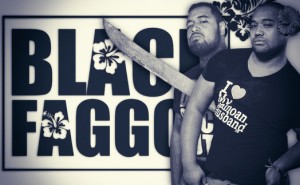
Black Faggot was the big winner at the Auckland Fringe Awards – winning Best Theatre, the Development award from The EDGE, the Auckland Arts Festival Award, AND the Tiki Tour Ready Award to take it to Melbourne Fringe – and Basement representative Sophie Vowell left with a big handful of wine to give to playwright Victor Rodger and his collaborators.
Black Faggot’s success – and inclusion in the Festival – says a lot about the Fringe itself. The title may be provocative – and an effective screener to dissuade anyone to whom the play might not be their taste – but the content itself is familiar, hilarious, with well toned deeper feeling. The play’s opening claims the potentially derogatory label as its own, then pushes beyond it to reveal the comedy and drama of life where Polynesianness and homosexuality is a starting point only, and not the final word. Rodger acknowledges his debt to Toa Fraser’s Bare (1998), a slice of life two-hander. That format, with actors playing multiple roles and little else in the way of set, is recognisably Fringe: a good solution for low-cost theatre-making, and an opportunity for clever theatricality and character building. Rodger however, unlike Fraser at his debut, is an established playwright (look out for Silo’s production of his Protection in August). Fringe becomes a platform where both those new – and further on in their careers – can experiment (see also best Cabaret Burlesque winner and performer Mika for Salon Mika). Matt Baker identified a few rough edges in his review, but wrote that Faggot is an incredibly accessible show.
Does the inclusion of a Victor Rodger in the Fringe make it more legitimate? Perhaps. The greater significance is that Fringe itself is seen as a legitimate and worthwhile place for practitioners at all stages to put on their work. The Fringe as creative laboratory is growing. This year, it really came ALIVE!!!
SECOND CHANCES
Black Faggot ran for only four nights and quickly became the show everyone wanted to see, but no-one could get into. Its inclusion in the Pride Festival didn’t hurt either, nor the appearances of Iaheto Ah Hi (from Sione’s fame), and Shortland Street hot new thing Beluah Koale (a Massive acolyte). For the many that missed it, it deserves to return – and will return. But it will not and should not be the only one from this Fringe.
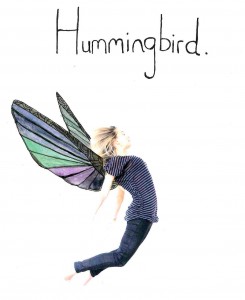
Spare a thought for the shows in the final week of Fringe. For the first time Fringe was extended for a further week – this proved a success in getting a good spread of attractions over the month, however in the final week burn-out could be perceived, and the Arts Festival arrived to take the attention. One show that may have got lost in the mix was Hummingbird . I only managed to get to it on its final night on the last night of the Fringe, and it was the perfect way to end my Fringe experience. I hadn’t got to write about it yet so I will do briefly here: The quiet pace of life on an inherited dairy farm of a young couple played by Chelsea McEwan-Miller and Barnaby Fedric is disrupted upon the arrival of half-sister Pheobe (Sophie Henderson), who seems in denial about the disappearance (and likely death) of her boyfriend Gavin, and the friction in the couple’s own relationship is thrown in stark relief. Phoebe announces she wants to fly. Lyrical and thoughtful, it was a moving ode to loss, hope, and belief. While Fredric especially played up the gentle humour of the piece, this was also the most mature work of Chris Neels (These are the Skeletons of Us, The Seven Funerals of Charlie Morris). Under the direction of Nic Sampson, flashy theatricality has been traded for an emphasis on strong character building. Neels himself is currently studying in London and was unable to see the efforts of his team by proxy. The word is that when Neels returns to New Zealand the play may be able to fly again, so keep Hummingbird on your radar.
I’d also be keen to see the return and continued development of La Vie Dans Une Marionette, Gorge and Just Above the Clouds… but more on those later.
Some shows you may not have to wait as long to get a second chance. Sainsbury and Parson’s schlocky horror Dolly Mixture returns to The Basement THIS WEEK. Mixture was part of a noticeable trend this Fringe to take an audience a little out of their normal comfort zone…
GROSS OUT

When Thomas Sainsbury and Yvette Parsons get together, you expect something a little out of the ordinary. But for this Fringe they rose against complacency to deliver their sickest work yet. Yes, there was the usual assortment of awkward, oddball and off-the-wall characters and humour (Parson’s Beverly Beavington is a terror), but they push further into territory that I wrote was “sick, twisted, gross, and just what this Fringe needs.”
With the atmosphere of horror established, the second half of the play is an endurance test for the audience as the play pushes into the sicker material. Sarah Houbolt joins the proceedings and adds her circus skills to the mix to create some truly surprising moments of the ‘can’t-believe-this-is-happening’ type (I will not spoil here)…. Dolly Mixture gets repeated reactions from the audience by exploring the Horror trope of abjection with some taboo bodily fluids. A scene between Sainsbury and a bucket, and an erotic dance with fans by Parsons, will likely be one of the most-talked about scenes of this Fringe.
Virginia Frankovich and Pheobe Mason’s Gorge meanwhile continually played with the lines between sweet, sickly sweet, and repulsive. Featuring the bizarre corruption of a 6-year-old girl’s birthday party, they lure us in with free and delicious cakes and goodies and a set design of pink puffery and a candy wonderland.
Gorge is probably the show that is the best value for your money in Fringe… you get a small bag of lollies, a token you can use to select from a table a decent sized treat including cupcakes and chocolate logs, they feed during the show, and if you’re still hungry, you are invited to sample the left-overs. You may not want to at show’s end… that’s because the play itself has a real push-and-pull of temptation and revulsion, culminating in a disgusting climax…
Honourable mention to another birthday party: Daryl Wrightson and Benjamin Henson’s Silly Hat Sausage Sizzle Spectacular Birthday Bash Bonanza Extravaganza which coaxed us with the initial appearance of a very camp light cabaret, then took us into the demented drug-trip-gone-oh-so-wrong.
PUPPETS AND MIME

One of the strongest and most rewarding trends of the Fringe was the number of shows that took non-traditional forms to tell their stories. Forms like mime and puppetry are nothing new, but what is new is to see locals use and explore them so cleverly and confidently, and this proved a refreshing change to the normal plays we otherwise get through the year. Perhaps it took the sublime puppetry of Australia’s Alvin Sputnik in 2011 for us to realise how magical such theatre can be within a Fringe environment, but this year it were the locals that stepped up to the plate and shone.
Ben Anderson has been perfecting his brand of visual theatre, and with Just Above the Clouds he created a work that Matt Baker described as transcendental. Performed by a group of actors turned puppeteers, it told the story of a boy who could not love because his heart was made of concrete – a metaphor that cleverly took the play into the realm of a universally relatable feeling. Anderson treats this audience as intelligent, feeding us out enough rope to attach our own meanings to his images, before pulling it back in to beautifully tie up his story. This one was also memorable for a cloud that rained puns.
Watching Just Above The Clouds I am reminded of films such as Waking Life, Eternal Sunshine of The Spotless Mind, and What Dreams May Come; poetic interpretations of the perception of life. Regardless of whether these were direct influences on Anderson, he has truly created an original story.
The Road that Wasn’t There by New Zealand’s Trick of the Light company, originally performed in the Edinburgh Fringe, was also an audience favourite. While Matt didn’t feel that sufficient pathos was realised, he praised the genuinely entertaining story presented via a mix bag of theatrical effects:
The script weaves between fiction and reality with great ease thanks to the spectacle elements of the show. Puppetry, shadow play, music, and live action all work in great cohesion to support the story-telling.
Puppets weren’t the only one’s capturing people’s hearts. Silent clowns offered beautifully funny and sad storytelling. One by One was both a heart-warmer, and a tear-jerker.
Performers Katie Burson and Cole Jenkins deliver a remarkable feat in One by One: not only making us care about two people who fall in love (without ever uttering a word), but doing so with highly physical flourish, making the performance something of an endurance test. Burson offered a heart-stopping moment in Fringe when we learnt that she had injured himself during the performance of opening night, and the second night had to be cancelled. She made a recovery for the subsequent nights, and watching her later in the season, you wouldn’t have known anything had gone wrong.
It is quite an achievement to address such a full spectrum of the human condition in a show, and I would challenge anyone who sees it, regardless of its tragic elements, to not be overwhelmed with a sense of overall optimism about life. Not one to readily bestow a standing ovation, I found the effortless action of rising to my feet during the applause a simple gesture of respect to the amount of energy and concentration these two actors had offered for a full 90 minutes. It is a feat that should not be underestimated, and it is a show that should not be missed.
My experience of One by One was complemented by La Vie Dans une Marienette, which also featured highly assured and consummate physical performances, but with a bit more cheek and grit. A story of a lonely pianist and a marionette who comes to life whenever music is played, I wrote that what I loved most what the show’s sense of play and freedom, the performers enjoying playing with us, not just for us.
The White Face men are a multi-talented crew. Justin Haiu employs his strong contemporary dance background to flop, twirl, flip, and makes it easy for us to suspend our disbelief and utterly conceive that he is not the master of his own movements. His marionette is an innocent discoverer who absorbs and copies his creator’s behaviors. Jarman’s pianist is harder to get a handle on: he’s damaged goods, holding pain inside his heart. Jarman plays him with a roguish, charismatic, and sometimes vain quality, but this seems to be a front: he’s fearful of outside contact, and at first fearful of the marionette, he slowly gives himself over. Jarman also gets to use his street dance background, and the high-point of the show is a joy filled dance duet between the pair.
I am hopeful that these sorts of shows reflect a growing impulse to play with ways of storytelling that go beyond just the spoken word, and that we’ll see plays of their like beyond just the Fringe environment.
GOING SOLO
There was no shortage of plays for one man or one woman in the Fringe.
Hairy Australian import Will Greenway bought his larrikin ‘Big Fish’ yarn A Night to Dismember to The Basement and recounted his character’s experience of multiple shark attacks and life without arms.
While the surface story is, frankly, hilarious bullshit, what emerges is a certain way of observing the world: as a ‘shark eats man’ sort of place. It is unjust, random, you are up against it, and other people/sharks can be real assholes.
Penny Ashton took away best comedic performer for Promise and Promiscuity, a mix of period froth and modern cynicism, in which she brilliantly performed a novel’s worth of characters.
Sisterly Love offered the chance to experience the same script with different solo actors (I caught male Ashton Brown performing as a series of different female family members gathered at a wedding – a nicely tuned script, however the novelty factor didn’t give me the desire to sit through it again with a different actress).
Tim Dibley would probably consider his Masterclass a solo show, but let’s not forget the valiant efforts of his casting assistant Lucky. Eryn Wilson’s Dibley, who was also invited to host the Auckland Fringe Awards, was the great inside-joke of the Fringe. A casting director himself, Wilson’s vain creation had the industry in stitches with his acting tips.
The most intimate and remarkable one-person show in Fringe – and the one that I still reflect on – is Freya Desmarais’s Home / The Hilarious Comedy About How I Nearly Killed Myself / A Play About How I Nearly Died But Didn’t Then Learned A Lot About Life Afterward (review) in which she brazenly, openly, and honestly theatricalises her experience when she considered taking her own life.
How do you make a comedy about your own attempted suicide? Can you? Should you? Desmarais confronts sensitive and triggering topics with an upfront candour, we trust her, we warm to her, we like her, and we go on the journey with her…. She’s touched a nerve here: something about finding a way through the unfathomableness of life, and about how sometimes it’s bigger than just you… Honest, brave, hilarious, touching, Home is a remarkable theatre piece to experience, and it achieves what great theatre can do: for an hour, we walk in her shoes, appreciating and understanding life from an alternate perspective.
OUTDOORS
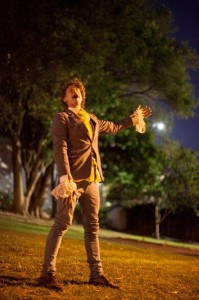
Fringe also enabled us to get away from the normal theatres. Celery Stories had the laudable goal of getting audiences out of the theatres and into the streets with their fairytale inspired promenade experience in Albert Park, however it didn’t quite live up to promise:
As part of the collective audience, it is hard to know what is expected of us, or where we need to go and when. Celery Stories doesn’t seem to have made up its mind if it a series of art-meets theatre installation pieces ala Art in the Dark, which the audience seeks on their own terms, or whether there is a continuing narrative which the entire audience gets to experience at the same time. As it was, the evening began to display a very anarchic spirit indeed, the actors improvising madly to keep some semblance of control. The simple moments of encounter worked beautifully: a Princess (Annabelle Harrison) dancing delicately on a series of upside down tea-cups, or the spellbinding charm of the Little Mermaid (Colleen Davis) singing on a rock as bubbles floated around here. Other times I felt I was missing out; in the wrong place at the wrong time.
Wet Hot Beauties meanwhile upped the ante with their water ballet Swan Song at the Parnell Baths, a truly impressive show that delivered in splashes:
You will never have seen a Swan Lake quite like this. The white swan becomes pink, and the black swan, blue. Props include surfboards and water pistols. While there is a nod to Tchaikovsky’s ballet score, Swan Song is told through a soundtrack of songs like Calvin Harris’s ‘Feel so close’, The Ting Ting’s ‘That’s not my name’, and even Rage against the Machine’s ‘Killing in the name’.
FINAL THOUGHTS
The standout of the Fringe was The Basement Theatre, who packed through their doors 33 shows within the 3 weeks of Fringe. “How the sh*t will you fit them all in?” The Basement’s promo material asked, but it seemed like a question more for themselves: “How the sh*t are you going to fit all of these in here Charlie?”. Under the capable management of Stacey Donaldson, who all Basement Fringe artists now owe a life debt, The Basement’s play-management was a smooth operation indeed, allowing for, for instance, an entire audience-enveloping tent to be erected in time for Wild Beasts to begin in The Basement Studio.
The Basement had all the best shows, including Jess Sayer’s Elevator, which saw 3 actresses stuck in an elevator as secrets and explosive revelations inevitably escaped while the characters remained claustrophobically stuck:
Director Cameron Rhodes finds a nice combination of tableaux, which the actresses gradually morph between without any hint of coercion, allowing for the physicality of the script to literally take shape (with moments of great back-acting from Gibson). The overall style of the play is slightly heightened, but only just enough to prevent enervation through naturalism. Palpable tension arises through not only the script, but also the potent pauses within it, resulting in a very well paced piece.
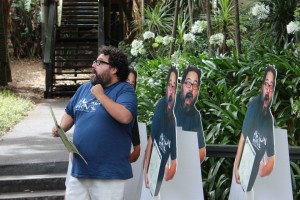
Part of The Basement’s success in attracting these shows was likely its risk-share policy, in which Fringe was its first try out, were The Basement take a cut of whatever tickets the show sells rather than an upfront fee. This was a game-changer for Fringe, and a step towards making Fringe shows sustainable for artists when audiences are not always ensured.
But more than this, The Basement was the place to be during Fringe. Their new classy and cool foyer – paid with the support of the theatre’s community via PledgeMe – opened just in time for Fringe, making it the ideal Fringe waterhole pre or post show.
Fringe has been and gone. But I still have the ticket stubs and programs to remind me of you.
So here’s to you Auckland Fringe! Until next time.
READERS: What memories of the Fringe remain for you? What were your standout productions? Comment below!


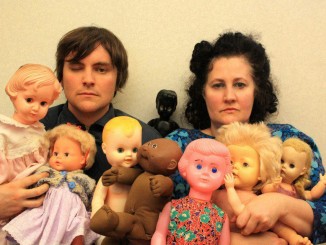
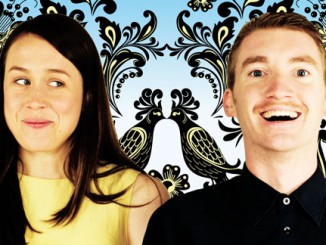
What an awesome write up, thanks for taking the time to do this! I agree this fringe fest was really really strong across the board, some really inspiring stuff! Overall I felt a real community vibe throughout, especially at my favourite, the Basement – hope the next AFF can build on this.